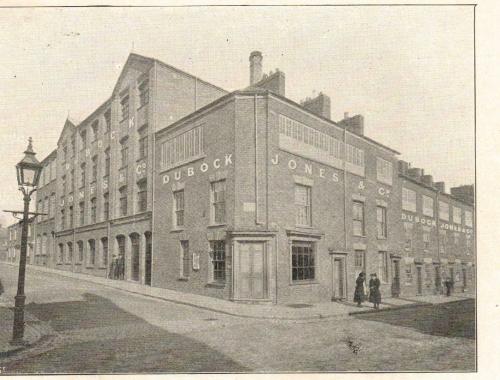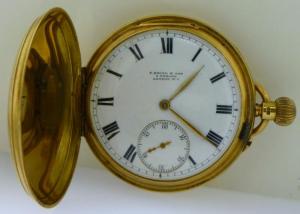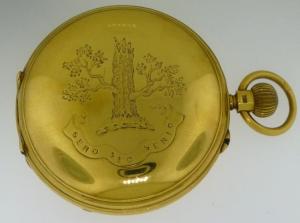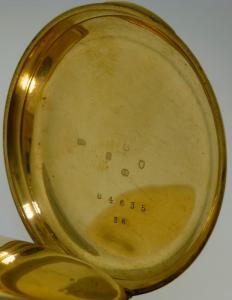|
Annewiggy
|
61 of 147
Sat 2nd Nov 2013 9:26pm
|
|
Annewiggy
Tamworth
|
62 of 147
Sun 3rd Nov 2013 4:46pm
Wellington Street 1896
 |
|
Coventry People -
Yardley family
|
dutchman
Spon End
|
63 of 147
Sun 3rd Nov 2013 5:32pm
Nice one Anne 
I'm guessing that's the corner with Yardley Street as shown on this slightly earlier map:

Your photo adds significant detail which isn't apparent when viewing the map alone. |
|
Coventry People -
Yardley family
|
Annewiggy
Tamworth
|
64 of 147
Sun 3rd Nov 2013 5:43pm
Thanks Dutchman, Yardley Street was probably named after my 7x great grandfather John Yardley who was Mayor of Coventry in 1689. |
|
Coventry People -
Yardley family
|
NeilsYard
Coventry
Thread starter
|
65 of 147
Sun 3rd Nov 2013 10:34pm
Brilliant - didn't know that Anne |
|
Coventry People -
Yardley family
|
dutchman
Spon End
|
66 of 147
Mon 4th Nov 2013 2:47am
Maybe he was yours as well Neil?
|
|
Coventry People -
Yardley family
|
NeilsYard
Coventry
Thread starter
|
67 of 147
Mon 4th Nov 2013 2:52am
I did always half wonder if there was a connection Dutchman. Anne's offered to assist with the family research - I'm 'only' back as far the mid to late 18th century (but still in Cov!) so we may well be linked. Rob's list on here has him down as a surgeon. The Yardley family in Coventry can be traced back to the 1500s. There was also a John Yardley alias Erdeleye (where the name derives from?!) who was Abbot at Kenilworth Abbey in 1458 - apparently! |
|
Coventry People -
Yardley family
|
Annewiggy
Tamworth
|
68 of 147
Mon 4th Nov 2013 11:48am
Although John Yardley, Alderman is on several lists as a surgeon he was actually a clothier, it was his son John who was a surgeon. Alderman John Yardley was son of Robert Yardley who was a miller and they seem to have lived for many generations after that in Bastille Mill. He also occupied a stone tower over Bastille Gate and was allowed access through the gate for his cattle to Spittlemoor. He had to kepp it in good repair and the corporation could repossess the gate for the city's safety. I have not been able to find out if the Yardleys were in Coventry before then. My Yardley family have been in Coventry, with occupations following the ups and downs of the history of Coventry until my Dad died in 2003, my generation like me have all moved away. Unfortunately I was only descended from a younger son of John who was a starchmaker and he went bankrupt in 1728. |
|
Coventry People -
Yardley family
|
NeilsYard
Coventry
Thread starter
|
69 of 147
Tue 5th Nov 2013 10:22am
Well we're all still here Anne - and my two sons will be carrying on the name here (though they spent their first ten years growing up in Berkswell). Definitely seems to be one of the older Coventry family names. There's also a couple of villages in Northampton called Yardley Hastings and Yardley Gobion - the church in Burton Dassett has a lot of Yardley graves there too - didn't we get about! |
|
Coventry People -
Yardley family
|
|
Midland Red
|
70 of 147
Tue 5th Nov 2013 10:44am
|
|
NeilsYard
Coventry
Thread starter
|
71 of 147
Thu 7th Nov 2013 4:14am
 I did have an aunt that bought me what was probably the full range of Yardley Gold every Christmas for about ten years which she thought was a right laugh. Probably had a few litres of the stuff!!  |
|
Coventry People -
Yardley family
|
coventry49
Budleigh Salterton, Devon
|
72 of 147
Sun 25th Jan 2015 2:59pm
I've only just joined the forum but can perhaps shed some light on the Palace Yard in Little Park Street. My mother was born there in 1921 and grandma lived there until 1961 when she was moved to Cheylesmore into a prefab, as they were demolishing Palace Yard. It was just a short way from the Police Station in the direction of the old Council House. A pear tree, which used to be at the bottom of the yard was still visible on a car park but may have been uprooted by now as I haven't been to Coventry for a number of years. The yard was medieval and should never have been demolished. You went under an archway and there were 2 houses each side of a cobbled area. A mounting block stood at the end for riders to mount horses. Grandma's house was the 2nd on the right as you entered the yard. Next came another arch with a house on the right (my aunt and uncle's the Yardleys) on the other side of this arch were a line of stables on the left and two more houses on the right. Then a toilet block! At the end of the yard were some gates and a wooden building, which housed Bushills paper works. They had been bombed out in the Blitz and moved to this temporary accommodation. Originally this area I was told had been an orchard. This would have backed onto Much Park Street eventually.
Grandma's house had no drainage for waste water. Just a cold tap in the kitchen and the dirty water had to be collected in a bucket and taken down the yard to the toilets. The houses must have been quite grand when they were built in perhaps the 15/16th century.
The Yard survived the Blitz, even though it was very close to the city centre. My family were in a shelter near the Cathedral on the night of 14 Nov and knew that the Cathedral was badly damaged as men were running into the shelter with what treasures they could carry. The Bird in Hand pub was one side of the Yard and Michelmores on the other. |
|
Coventry People -
Yardley family
|
coventry49
Budleigh Salterton, Devon
|
73 of 147
Sun 25th Jan 2015 3:39pm
The mounting block is clearly visible in one of the photos [on Pictures of Coventry] also my cousin, Trevor in his wheelchair under the outer archway. Can't work out where the ornate arbour must have been because neither my grandma or aunt had a back garden nor did any of the other houses as far as I knew. It could have been in the orchard area at the end of the yard though. |
|
Coventry People -
Yardley family
|
NeilsYard
Coventry
Thread starter
|
74 of 147
Thu 28th Jan 2016 1:24pm
On 25th Jan 2015 2:59pm, coventry49 said:
I've only just joined the forum but can perhaps shed some light on the Palace Yard in Little Park Street. My mother was born there in 1921 and grandma lived there until 1961 when she was moved to Cheylesmore into a prefab, as they were demolishing Palace Yard. It was just a short way from the Police Station in the direction of the old Council House. A pear tree, which used to be at the bottom of the yard was still visible on a car park but may have been uprooted by now as I haven't been to Coventry for a number of years. The yard was medieval and should never have been demolished. You went under an archway and there were 2 houses each side of a cobbled area. A mounting block stood at the end for riders to mount horses. Grandma's house was the 2nd on the right as you entered the yard. Next came another arch with a house on the right (my aunt and uncle's the Yardleys) on the other side of this arch were a line of stables on the left and two more houses on the right. Then a toilet block! At the end of the yard were some gates and a wooden building, which housed Bushills paper works. They had been bombed out in the Blitz and moved to this temporary accommodation. Originally this area I was told had been an orchard. This would have backed onto Much Park Street eventually.
Grandma's house had no drainage for waste water. Just a cold tap in the kitchen and the dirty water had to be collected in a bucket and taken down the yard to the toilets. The houses must have been quite grand when they were built in perhaps the 15/16th century.
The Yard survived the Blitz, even though it was very close to the city centre. My family were in a shelter near the Cathedral on the night of 14 Nov and knew that the Cathedral was badly damaged as men were running into the shelter with what treasures they could carry. The Bird in Hand pub was one side of the Yard and Michelmores on the other.
Just a quick mention to coventry49 - are we related as I've been looking in to this topic as the Yardleys you mentioned (about a year ago?!) are related to me! 
|
|
Coventry People -
Yardley family
|
Annewiggy
Tamworth
|
75 of 147
Sun 7th Feb 2016 1:04pm
This watch was auctioned yesterday in the USA. The watch case was made by John Yardley of Thomas Street, Coventry, who was my great great granddad. I am always amazed that such beautiful objects were made, when you visit places like the watch museum, and see what basic facilities they had to live and work. I should imagine that they even had to make their own tools and equipment, no ebay to click on to get almost everything you want. Sadly the watch sold for about £2,000 including the buyers premium, hopefully one day one will come up that is more in my price range !
   
An Extremely Fine and Rare 18k Gold Hunter Cased Keyless Lever Pocket Watch from S. Smith & Sons, 9 Strand, London, Watchmakers to the Admiralty. Keyless winding engaged by depressing a button in the band. A beautiful tapered collar protects the time set pin located near the upper pendant. Movement marked #84-635. Incredible 18k Yellow Gold Case made by John Yardley, Thomas Street, Coventry and hallmarked with a 1852 Birmingham date mark. The case is engraved with the Latin Motto Sero Sed Serio (Late but in Earnest), the other side with a ornate monogram. The watch was most probably from one of the Nairn Baronets, the family crest and motto is theirs and the Monogram does have a large N. In good working order. The watch weighs approx. 67.50 dwt (105.10 grams). PROVENANCE: A Charleston South Carolina Private Collection. Smith & Sons were a leading firm in London for high quality and fine complicated watches in the 19th and early 20th century. S. Smith & Son was founded in 1851 by the jeweler and watchmaker Samuel Smith. In addition to the wide range of watches and clocks for private customers, Smith's also built reliable chronometers which made the firm a supplier to the Admiralty. Under the management of Herbert S.A. Smith, the firm developed into a large manufacturing company that had its own research laboratories; in the next generation Sir Alan Herbert Smith extended the company product range further and began with the production of automobile and aircraft instruments. Around this time a period of general decline for British horology began; even so, a few British watchmakers created magnificent, ultra-complicated watches, as if to prove to the world that they were still the best. Some of these watches were made in collaboration with the most renowned Swiss watch companies. Charles Frodsham, Edward John Dent, and Samuel Smith were the London watchmakers best known for this, as well as J. W. Player in Coventry . Even among all the British Grand Complication watches of the 20th century this watch stands out. Its dial was made by the famous British maker Willis, whose dials are always outstanding. The movement is equally exceptional. It is large and has a very cleverly designed mechanism; it often utilizes the same arbor in the cadrature for two functions and is finished with extreme attention to detail. Some of the solutions, although not new, employ innovative ideas. |
|
Coventry People -
Yardley family
|
